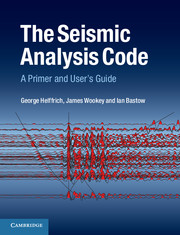Book contents
- Frontmatter
- Contents
- Preface
- Acknowledgements
- 1 Introduction
- 2 The SAC data format
- 3 The SAC processing philosophy
- 4 Basic SAC commands
- 5 SAC macros
- 6 Accessing SAC functionality and data from external programs
- 7 Graphical data annotation
- 8 Array data handling
- 9 Spectral estimation in SAC
- 10 Three-dimensional data in SAC
- 11 Implementation of common processing methodologies using SAC
- Appendix A Alphabetical list of SAC commands
- Appendix B Keyword in context for SAC command descriptions
- References
- Index
- Plate Section
9 - Spectral estimation in SAC
Published online by Cambridge University Press: 05 October 2013
- Frontmatter
- Contents
- Preface
- Acknowledgements
- 1 Introduction
- 2 The SAC data format
- 3 The SAC processing philosophy
- 4 Basic SAC commands
- 5 SAC macros
- 6 Accessing SAC functionality and data from external programs
- 7 Graphical data annotation
- 8 Array data handling
- 9 Spectral estimation in SAC
- 10 Three-dimensional data in SAC
- 11 Implementation of common processing methodologies using SAC
- Appendix A Alphabetical list of SAC commands
- Appendix B Keyword in context for SAC command descriptions
- References
- Index
- Plate Section
Summary
SPECTRAL ESTIMATION
Spectral estimation is the task of taking a time series and decomposing it into its component frequencies. The total length of the time series and, if it has been sampled at a fixed time interval, the inter-sample spacing control the minimum and maximum frequencies that the time series contains. Different methodologies may be used to estimate the power at each frequency at constant intervals between these bounds. This so-called power spectrum provides a way to quantitatively characterize the frequency content of the time series. The information is usually presented in the form of a graph of power versus frequency.
The power spectrum informs further processing avenues for the time series. Usually this involves discrimination of any signal in the spectrum from noise. If the signal is of high quality, the signal's power will dominate the noise. Thus the power spectrum will be peaked in a frequency band containing the signal. If the goal is to design a filtering strategy to minimize the noise, this analysis will suggest the type of filter and the corner frequency to use. Another application might be to seek tidal resonances at a coastal site based on repeated sea level measurements, or a marigram. In this case, the frequencies of the spectral peaks are the desired information, and perhaps their widths or positional uncertainties.
Spectral estimation is technically complex due to the characteristics of the signal under study.
- Type
- Chapter
- Information
- The Seismic Analysis CodeA Primer and User's Guide, pp. 109 - 114Publisher: Cambridge University PressPrint publication year: 2013

